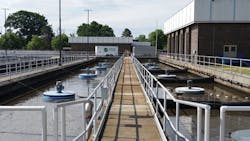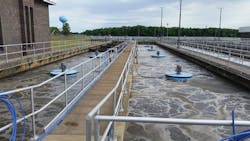Oxygen Supplemental Delivery Study at Genesee County Wastewater Plant
By Frank J. Tokar Jr. and Glenn S. Burkhardt
The Anthony Ragnone Wastewater Treatment Plant (ARWTP) in Genesee County, Mich., has been recognized by the Environmental Protection Agency (EPA) as one of the most efficient wastewater treatment facilities in the country. In order to assess the efficiency of its existing fine bubble diffuser equipment, ARWTP engaged Greener Planet Systems to conduct a side-by-side evaluation of its PrO2 system to determine if it could increase the capacity of the aeration tank while reducing operating costs through utility savings.
Natural Resources Management LLC (NRM) was retained by the Genesee County Drain Commissioner, Water and Waste Services Division, to provide oversight, data analysis and performance evaluation for the supplemental oxygen injection study. During the study, the oxygen that is normally supplied using blower-forced air and fine-bubble diffusers was shut down in the first pass of a four-pass aeration tank (trial tank T1). Supplemental oxygen was then delivered to the first pass of the trial tank T1 using the PrO2 system to replace the oxygen normally provided by the fine bubble diffusers.
The PrO2 system uses a compressed oxygen source (>93 percent O2 at 300 psi) dissolved into a supersaturated slip stream or carrier fluid so it can be injected into the target area at the molecular level as opposed to a bubble state. The PrO2 slip stream was injected into the beginning of the aerobic zone in the first pass of trial tank T1. Reduced air flow volumes were maintained in the subsequent passes of the trial tank.
Air flow in the adjoining aeration tank (control tank T2) was maintained at normal operating conditions using blower-forced air only for comparison during the study. A steady primary effluent (PE) flow between 5 million and 6 million gallons per day (gpd) was maintained throughout the course of the study into both aeration tanks. The blower-supplied air was maintained using a 1,250 hp blower. Suspension of the mixed liquor was maintained using two 7.5-hp mixers within the first pass of the trial tank T1 in place of the diffusers. The daily influent flow, volume of blower-supplied air to the diffusers, volume of oxygen (pounds) used by the PrO2 units and volume of the PrO2 slip stream (gallons) being introduced into the aeration tanks were monitored and quantified.
Composite samples were collected from the primary and final effluent and the mixed liquor in the aeration tanks prior to and during the study. The effluent data included laboratory analysis of dissolved oxygen (DO), biochemical oxygen demand (BOD), total suspended solids (TSS), ammonia and total phosphorus (TP). Daily profiles of the mixed liquor in each pass of the aeration tanks were created from grab samples analyzed for DO concentration, oxidation-reduction potential (ORP), ammonia, TP and mixed liquor suspended solids (MLSS). The grab samples were collected at stationary sample locations within each pass of the aeration tank. A general microscopic evaluation of the microbiology in the mixed liquor was evaluated toward the end of the study to document notable changes.
During the course of the study, the air being delivered to the trial tank T1 was reduced to a rate where the desired ammonia and phosphorus uptake was maintained to mimic the desired end result being realized in the control tank T2. This was measured by the daily profile and final effluent analyses. The oxygen delivered to the control tank T2 in order to maintain the desired organic and nutrient reduction was calculated to be approximately 10,320 lbs per day. In comparison, the same nutrient uptake was achieved in T1 when the air delivery was reduced to 8,380 lbs per day as the PrO2 units delivered the supplemental oxygen - a difference of 1,940 lbs per day. Therefore, it was expected that the volume of oxygen that would need to be delivered by the PrO2 system to maintain the desired organic and nutrient uptakes would be 1,940 lbs per day. This calculation was based on an oxygen transfer efficiency rate of the fine bubble diffusers (26 percent).
The actual amount of supplemental oxygen supplied by the PrO2 system needed to maintain the desired organic and nutrient uptake was 432 lbs/day. This indicates the oxygen utilization efficiency for the PrO2-delivered oxygen is approximately 4.5 times (450 percent) greater than fine-bubble aeration. The efficiencies are most likely due to the oxygen being introduced at a molecular level with the PrO2 as opposed to a fine-bubble state using blower-supplied air to the diffuser grid.
Prior to the study, the anaerobic zone in the trial tank T1 and control tank T2 was confined to the first pass or 12 percent of the total effluent volume of each aeration tank. This was documented by DO, ORP and nutrient profile data. During the trial period, this zone was extended in the trial tank T1 to approximately 50 percent of the total tank effluent volume (all of pass 1 and pass 2) within 10 days after the PrO2 system was activated.
Nutrient removal and DO residual were maintained further downstream in the trial tank T1 than in the control tank T2 during the course of the study with less air input from the fine bubble diffusers. The data shows that the ammonia and phosphorus uptake rates in the aerobic zone were higher in the trial tank T1 when compared to the control tank T2 at the same flow rates but at different locations within the tank hydrology.
Calculations based upon the daily flow rates, the air input required to meet the treatment target concentrations for ammonia and TP, and the final effluent concentrations show that the treatment goal can be achieved with approximately 30 percent less tank volume. These results indicate that changing the volume of the anoxic zone with the PrO2 system increased the tank efficiency. This effect would not be desirable in a conventional aerobic system; however, it did not affect the performance of microbial activity in the trial tank T1.
Mixed liquor solids concentrations were compared in the trial tank T1 and control tank T2 during the course of the study. It can be shown that the solids concentration in the trial tank T1 increased by 5 percent during the study and was realized within 10 days of PrO2 injection. This suggests that the microbiology was more active in the trial tank T1 and the PrO2 injection may have had an effect on increasing microbial activity and/or a reduction in wasting while observing the tank performance. No detected changes in the general microbial community were noted during the study in either tank.
By comparing the oxygen needs of the trial tank T1 with the control tank T2 before, during and at completion of this study, it was shown that the PrO2 system-enhanced aeration tank was approximately 4.5 times more effective at oxygen utilization than the conventional fine bubble diffusion system that is currently used at the ARWTP.
At the beginning of the trial, the estimated net power usage for the PrO2 tank was lowered by 15 percent and can be transferred directly into cost savings when compared to the required electrical demand of the fine bubble diffusion system. From the data gathered in this study, a more permanent design for the supplemental oxygen can now be developed to calculate return on investment and direct cost savings in utility expenses.
Indirect cost savings can also be demonstrated by showing the significantly higher oxygen utilization efficiency that is most likely due to the method of delivering oxygen at a higher concentration (>93 percent in liquid oxygen tanks) and at a molecular scale as opposed to oxygen made available using fine bubble sizes and air that is only 21 percent oxygen. When coupled with the likelihood of less off-gassing realized by the PrO2 system, it is possible that this method of supplemental oxygen delivery will allow for future increases in treatment capacity without the capital costs of additional footprint construction and conventional air diffusion equipment.
Editor’s Note: You can read the full white paper at waterworld.com/whitepapers. About the Authors: Frank J. Tokar Jr. is a geologist with Natural Resources Management LLC (Sylvania, Ohio). Glenn S. Burkhardt is a professional engineer (PE) with Engineered Logic LLC (Clinton, Mich.). The PrO2 system is manufactured by Blissfield Manufacturing Company in Blissfield, Mich., and is distributed by Greener Planet Systems. To find out more, please visit Greener Planet Systems at greenerplanetsystems.com.




